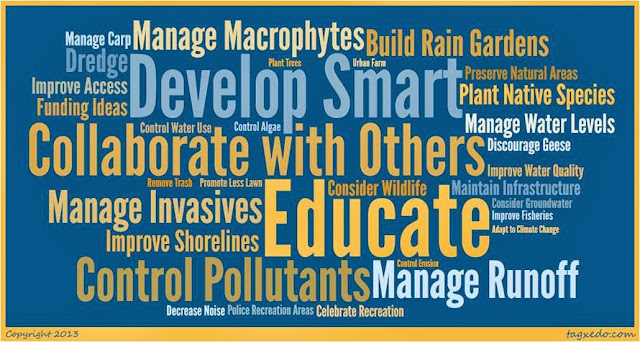Nearly a hundred residents came together in a series of Community Conversations in three locations within Ramsey-Washington Metro Watershed District between mid-September and early October to learn more about the history of the District, the budget, initiatives and recent accomplishments. Much of the time was devoted to getting input from participants. People reflected on how they value and interact with the District’s lakes, wetlands and creeks, identified many of their concerns and offered potential ideas about addressing watershed issues.
The meetings were held in Maplewood, Woodbury and Shoreview for the central, southeast and northeast areas of the watershed district respectively. These gatherings were designed to help us begin the public input process in updating our management plan. Every ten years the management plan is revised to keep abreast of current issues and changing conditions in lakes, wetlands and streams. Updating the plan will spread out over the next two years. Input from the public is vital!
 People who participated in the Community Conversations were very forthcoming about the importance of lakes, wetlands and creeks in their lives and the personal value they offer. Their collected comments provide a rich portal into the relationships local residents have with water bodies in the District. Here are some quotes that help capture the feelings and connections people shared about their local water resources.
People who participated in the Community Conversations were very forthcoming about the importance of lakes, wetlands and creeks in their lives and the personal value they offer. Their collected comments provide a rich portal into the relationships local residents have with water bodies in the District. Here are some quotes that help capture the feelings and connections people shared about their local water resources. “I love the variety of wildlife. Fish, birds, waterfowl.”
“I gaze in wonder at the juxtaposition to high traffic.”
“They keep us all healthy & sustain life around us. They’re beautiful & create a sane place for people to experience nature.”
“I find value in native plants on the shoreline.”
“I value the joy of living on the lake.”
“I most value the clean, clear water and the ease of access for recreation. “ “Coming from a country that doesn’t value water, the lakes and ponds here are treasures that need to be preserved.
“Watching wildlife on the water helps me calm down.”
“I take my grandkids fishing on the lake. “
“I love the beauty, tranquility, & peacefulness.”
“I value nature in the city with recreational opportunities.”
The pie chart below quantifies how residents who attended the meetings interact or use water resources in the Watershed District. The two top choices involve boating (including kayaking and canoeing) and a category that includes walking, hiking and running. Here’s the list we got from participants by percentage of responses.
For a list of the top 20 visited water bodies in the District (as measured by attendees of all three meetings) see the table below.
After sharing this personal information, the content of the evenings shifted as participants brainstormed and challenged each other to dig deeper while generating an expanded list of issues/concerns in the watershed. These exchanges generated many community concerns including invasive species, animal habitats, stormwater and other pollutants, water quality, water levels, aquatic vegetation (macrophytes), increased development/impervious surfaces and the need for education and maintenance. For a complete list of the issues and concerns raised during these sessions see the pie chart below.
A second round of small group interchanges precipitated insights and suggestions to address the problems and make improvements. Each night the discussions culminated in a large group sharing of key issues and ideas for improvement.
Here’s a break out of suggested actions/solutions/improvements that the group generated.
 |
| Actions and solutions suggested. Larger words were more often mentioned, smaller means less often. |
The content of these meetings is being compiled and further analyzed by Watershed staff and Barr Engineering consultants to help provide public perspective and direction in the District’s management plan update process.
This series of meetings will not be the only opportunity for public input for the revisions to the management plan. Next phases of this process include fall meetings with city councils/commissions, a number of other approaches to gathering community input as well as a public summit to be held in early January 2014. Watch for announcements!
The Watershed District hopes that these conversations will provide a foundation and impetus for further dialogue, input, public involvement and stewardship as the plan unfolds, is finalized and is implemented. It was clear from our dialogues that many of the people who attended the meetings are already involved in tracking and/or working on issues and have an interest in being involved in helping to implement solutions to current or emerging problems. We look forward to more input, involvement, future conversations and actions with everyone!
Please use the comment boxes below or in our open forum to indicate any ideas you have related to your own concerns, issues, and possible solutions.















s.jpg)

s.jpg)


